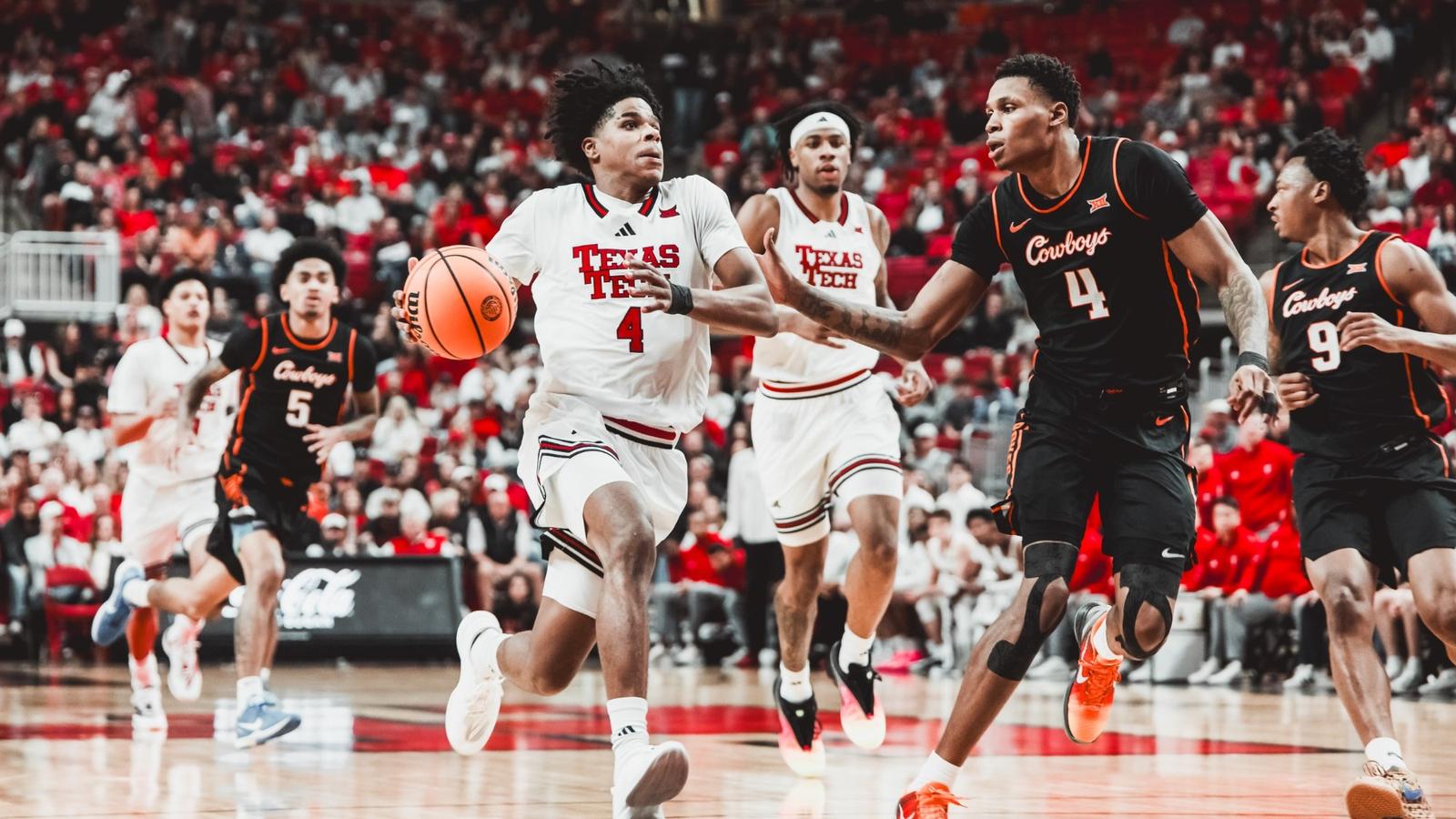LUBBOCK – No. 15 Texas Tech opened Big 12 play with a 102-80 win over Oklahoma State in a game where the team matched a program record with 17 3-pointers and saw all five starters finish in double-figure scoring. JT Toppin and Christian…
Blog
-

Waiting for the Out review – totally magnificent TV about philosophy in prison | Television & radio
It’s hard to imagine a better route into true philosophical inquiry than time in prison. Regret, causality, the nature of freedom: these are urgent issues to the incarcerated. Time is both impossibly empty and passing at terrifying speed. You…
Continue Reading
-
Bowling Green 101-100 Massachusetts (Jan 3, 2026) Game Recap – ESPN
- Bowling Green 101-100 Massachusetts (Jan 3, 2026) Game Recap ESPN
- Wendel: Welcome to the new normal Massachusetts Daily Collegian
- BGSU men’s basketball downs UMass in overtime BVM Sports
- Miami Moves to 15-0; Bobcats Seal Comeback at Buzzer
Continue Reading
-

Diving Competes In Tri-Meet With Miami & Notre Dame Saturday
CORAL GABLES, FLA. – The North Carolina diving squad kicked off the new year in south Florida with a tri-meet against Miami and Notre Dame on Saturday. Sofia Knight represented the women’s squad, while Christopher Booler, Carter Loftin, Ciro…Continue Reading
-

Thousands evacuated from Pimicikamak Cree Nation after homes, water treatment plant damaged in power outage
Listen to this article
Estimated 3 minutes
The audio version of this article is generated by AI-based technology. Mispronunciations can occur. We are working with our partners to continually review and improve the results.
The chief of Pimicikamak Cree Nation says hundreds of homes have been “severely compromised” in the aftermath of a days-long power outage that damaged a water treatment plant and plumbing systems, and about 4,000 people have been evacuated from the northern Manitoba First Nation.
Residents in Pimicikamak, about 530 kilometres north of Winnipeg, started reporting burst pipes, leaks and sewer backups after power restoration began on Thursday. All power was back on as of Friday afternoon, Manitoba Hydro said.
The power to the First Nation, which has an on-reserve population of around 7,000, went out last Sunday night after a power line that crosses the Nelson River snapped, and pipes froze in the extreme cold, as temperatures dropped well below the –20 C mark.
About 200 homes have been damaged by leaking pipes, Chief David Monias said during a news conference on Saturday. Those homes are no longer safe to live in, he said.
Monias said more homes may have been damaged as pipes quickly thawed, but the First Nation needs additional help to inspect dwellings and community infrastructure for cracks and leaks.
“Just because you don’t see a visible leak doesn’t mean that there’s no damage. There could be cracks in there that are waiting to burst the pipes.”

Pimicikamak Cree Nation Chief David Monias, seen here during a Wednesday news conference, has put out a call for help from plumbers, engineers, carpenters and electricians across the Prairie provinces. (Darin Morash/CBC) Repairs will likely cost at least $44 million, Monias said, and he is currently working on a recovery plan for the community.
On Friday, he put out a call for help from licensed plumbers across Manitoba, Saskatchewan and Alberta. He previously requested help from the Canadian Armed Forces as well.
“We need engineers, plumbers, electricians, carpenters — we don’t have enough in the community,” he said.
Pimicikamak band Coun. Shirley Robinson said the outage has caused “tremendous damage to our Nation.”
A water treatment plant on the north side of the community has seen major leaks, and help is needed to fix the aging infrastructure, she said.
“Our water treatment plant is ready to collapse.”
Some residents are being evacuated to protect their health and safety, said Robinson. At least 140 people were expected to be evacuated on Saturday.
Monias said about 4,000 people have already been evacuated from the First Nation.

Jack Ross said his family was evacuated after his mother, who has asthma, was struggling to breathe when her inhaler froze due to the extreme cold during the power outage. (Travis Golby/CBC) Jack Ross and his family were among the first to be evacuated to Winnipeg. He said his mother, who has asthma, was struggling to breathe after her inhaler froze due to the extreme cold during the power outage.
It was “very frosty” inside the multi-generational home, he said.
“The babies were crying on and off because they were cold.”
Ross said he’s worried his family will have to stay in a hotel for a long time due to ongoing plumbing issues.
“Being away from home is frustrating,” he said.
MaryJane Scott, who arrived in Winnipeg on Thursday morning before the power came back on in Pimicikamak, said she thinks evacuees could be stuck in the city for a while.
“I’m worried about going back because of the pipes,” she said. “It’s going to take time to fix the pipes.”
Continue Reading
-

Data centers seeking a home face increasing local opposition
Plans to place computerized data centers are drawing protests from residents in many parts of Japan, who aren’t happy about their nondescript facades nor see any benefits from hosting them.
The demand for data centers (DCs) is growing exponentially amid advances in artificial intelligence, among other factors.
Data centers proving unpopular among locals seem puzzling, given that these establishments provide perks, such as increased tax revenue, for regional communities.
Turning to those advantages, Inzai, Chiba Prefecture, outside Tokyo, has been recruiting data center operators so aggressively that the city is known by the nickname “DC Ginza” in tribute to the busy Ginza shopping district in the capital.
A tour of one of Japan’s leading data center clusters, as well as its surrounding municipalities, provides a look at the enigmatic situation facing the essential facilities in an era of information technology.
Inzai city saw a spate of data center building projects get under way rapidly during the 2010s. It is currently lined by a total of 30 such establishments operated, for example, by the U.S. Google LLC and an affiliate of Amazon.com Inc.
The municipality attracted considerable attention among business operators because it is particularly resistant to flooding and other natural disasters, thanks to its stable ground. Likewise helpful was the city’s prime location, easily accessible from central Tokyo and Narita Airport.
Construction is still progressing in locations across Inzai, with the number of data centers projected to reach 45 or so by 2028.
TAX INCOME MORE THAN DOUBLES OVER DECADE
Inzai city has been fully reaping the benefits of accommodating data centers.
Data centers are subjected to a higher permanent asset tax rate than logistics warehouses and similar facilities, since taxation applies to the servers densely arranged on respective floors, in addition to the land and buildings.
Servers used at data centers are costly, in particular. They need to be replaced every few years to keep pace with technological advances, helping stabilize tax revenues for host municipalities.
Proceeds from permanent asset taxes were 16.5 billion yen ($105 million) for Inzai city in fiscal 2024, more than double the 7.9 billion yen recorded 10 years ago.
Former Inzai Mayor Masanao Itakura, who led the municipal initiative to attract data centers, recounted how their existence has contributed to an improved quality of life for citizens.
“A lot of public services, inclusive of providing free meals to students at elementary and junior high schools, were made possible owing to the financial support from tax yields from data centers,” Itakura said.
However, land redevelopment in Inzai is already approaching its limits.
Home to a plethora of data centers, the Otsuka district in front of Chiba Newtown Chuo Station is fully occupied by existing and planned establishments.
The DPDC Inzai Park, which sits north of Inzai-Makinohara Station, no longer has any vacancies, and the same is true for the other major data center site, the Matsuzaki industrial complex, in southern Inzai.
The specialized premises suitable for setting up data centers for industrial purposes in urbanization-restricted zones are now occupied virtually to the fullest.
MASSIVE POWER USE
The local energy supply grid is similarly constrained and burdened.
TEPCO Power Grid Inc. stated that the Inzai area has gone through two rounds of substation enhancement in anticipation of rising electricity demand at data centers there.
The current energy supply capacity comes to 1.7 gigawatts, enough to power 480,000 average households. This figure is a result of an unprecedented investment in the city with a population of only 110,000.
The energy distribution still falls short of actual needs.
TEPCO Power Grid is looking to hike capacity by an additional 0.6 gigawatt by fiscal 2027. Even with this boost, the available power will be insufficient to meet the estimated total consumption of existing and envisioned data centers.
The utility is considering further investment, yet a public relations representative of TEPCO Power Grid acknowledged that the process “is believed to take some time.”
An executive of the operator of a data center in Inzai noted that more businesses are currently looking outside the city.
“Although few locations are better suited than Inzai, adequate sites are scarce, making it unrealistic to plan new construction projects going forward,” said the senior official. “Operators are increasingly turning their attention en masse to regions outside Inzai.”
LOOK BEYOND INZAI
Having lost sight of the “most appropriate site” for them, data center firms are setting their eyes on regions around Inzai, provoking a hostile reaction from residents at times.
A program was unveiled in 2022 toward putting a data center in Nagareyama in Chiba Prefecture.
Featuring four stories above ground and one basement, the facility was expected to boast an overall floor space of 34,000 square meters on commercial land near the city hall.
People living in the neighborhood did not roll out the red carpet for the massive building, as data centers offer almost no local jobs and contribute little to the vitality of the regional communities.
One opponent in Nagareyama thus noted the planned establishment could simply “create an oppressive atmosphere when seen from Nagareyama Station.”
Another voiced opposition, insisting, “It is easy to imagine that a data center (near a residential area) would be deemed as an unwelcome facility” among citizens.
The third-party committee set up by Nagareyama city held a mediation meeting, only to find that the developer had dropped the plan in 2024.
“The data center was not even anticipated” by residents, pointed out a representative from the city planning division of Nagareyama. “They may have thought of the large, sparsely windowed building, with effectively no people coming or going, as unsettling.”
The previous candidate site for the data center is reportedly undergoing the construction of an apartment and a commercial facility for now.
Residents of Shiroi, Chiba Prefecture, are alike raising objections, as more than one data center building program has been proposed there. They claim that this type of facility could “cast shadows and infringe on their right to sunlight.”
Even in Inzai, the leading host city, Mayor Kengo Fujishiro has questioned an endeavor to install a data center in a prime location in front of Chiba Newtown Chuo Station on the Hokuso Line.
Fujishiro wrote on his social media account: “An establishment appropriate to the community should be developed there–not a data center at this time.”
Locals have launched a drive to stop the facility as well.
It is, however, extremely difficult for residents and authorities to pressure data center operators to give up their construction in succession.
Unlike factories and cemeteries, data centers are free from regulations on construction and installation from the perspective of emissions, noise and negative public health effects.
With no apparent disadvantages to surrounding areas anticipated, data centers are therefore treated as “offices” in legal terms.
Keeping this background in mind, a municipal official expressed concerns, saying, “Stopping a building program is impossible as long as the procedures are legal. Resorting to excessive tactics could instead expose us to lawsuits.”
Continue Reading
-

Can-do attitude fuels bar chain that offers tinned food to drinkers
OSAKA—A chain of bars whose cuisine consists of canned food is on the comeback trail and increasingly targeting foreign travelers.
Clean Brothers Inc.’s first bar, called Mr. Kanso, opened in the Minami-Horie district in Osaka’s Nishi Ward in 2002. It featured the unconventional service of selling canned food to imbibers and allowing them to consume the products in-store.
Mr. Kanso bars offer about 300 varieties of canned delicacies from around Japan, such as “takoyaki” (octopus dumplings), “dashimaki” (Japanese rolled omelet) and Miyazaki beef.
The number of franchisees across Japan had reached 44 in 2015.
But the figure has dropped to 32 in 2025, a consequence of the COVID-19 pandemic.
“Everyone’s lifestyle changed,” said Michio Kawabata, 37, a board member in charge of public relations. “It seems many people shifted to drinking at home.”
FAMILY AFFAIR
The company is named after a project initiated by a group of artists led by Kawabata’s father Yoshihito, 71.
When Yoshihito was creating modern art pieces, he was also working as a manager for office buildings.
In 1998, he came up with an idea to clean up communal areas of buildings and lend the empty spaces to artists to display their works.
Yoshihito joined hands with eight others to found Clean Brothers, hoping to give young artists the exposure they needed.
A warehouse company asked them to operate a shop at a planned redevelopment site for a limited time. Thus, the first Mr. Kanso bar was born.
Clean Brothers decided to offer only cans of food at the bar because they have a long shelf life and require almost no cooking.
Customers would choose their favorite cans from shelves, move to the bar counter, and eat the contents with drinks.
The strategy proved successful.
Yoshihito serves as chairman of Clean Brothers, while his first son, Keiji, 42, is president and second son, Takeshi, 40, is managing director. Michio is the third son.
Clean Brothers’ product information states that it offers “‘omoroi’ (amusing) products born from a flash of inspiration.”
At least 20 of them are original items, including a can of takoyaki, which is priced at 635 yen ($4). It once sold about 10,000 cans a year.
Other original brand canned products are “happosai” (stir-fried mixed vegetables), “chanko-nabe” hot pot, paella and even cheesecake.
CONSTANT ADJUSTMENTS
Clean Brothers is aware it can’t compete on price with major seafood companies that can distribute mass-produced canned products to retailers.
The bar company’s product development has largely been a long trial-and-error process.
In canning, food is sealed in a container and sterilized by heat.
But the initial problem with takoyaki dumplings was that they melted with sauce while being heated.
Clean Brothers made adjustments, including thickening the sauce, to accumulate know-how.
The challenge for dashimaki omelet was how to keep the color, shape and firmness.
Mr. Kanso is now growing popular among the increasing numbers of inbound tourists for its novelty. The tourists have created a new business opportunity for Clean Brothers.
The majority of foreign customers want to return home with souvenirs of things they have tasted in Japan, the company said, adding that they prefer “luxury items.”
Canned beef, tuna, scallops and other high-end products sell well among them, the company said.
Cans of flavored nuts are also enjoying brisk sales.
Following takoyaki, wasabi and curry-themed flavors, the company is set to release the “mentaiko” (hot pollock roe) flavor.
“We will continue performing trial-and-error experiments,” Michio said.
Currently, Clean Brothers directly manages four Mr. Kanso bars and operates an online shop.
The company opened a Mr. Kanso in Taiwan in 2019, although it is now closed. The canned food bar also came to Hong Kong in 2021.
Continue Reading
-

Bulldogs Battle Past Tigers In SEC Thriller
By John Frierson
Staff WriterIn an SEC opener with a bit of everything, from blocks and dunks galore to 50 combined fouls, plus a buzzer-beating jumper to force overtime by Auburn, the No. 23-ranked Georgia men’s basketball team closed the extra…
Continue Reading
-

Depth of slab breakoff in Archean: the role of radiogenic heat production of continental crust and eclogitization of oceanic crust
Schellart, W. P. Quantifying the net slab pull force as a driving mechanism for plate tectonics. Geophys. Res. Lett. 31, (2004).
Huw Davies, J. & von Blanckenburg, F. Slab breakoff: A model of lithosphere detachment and its test in the magmatism…
Continue Reading

